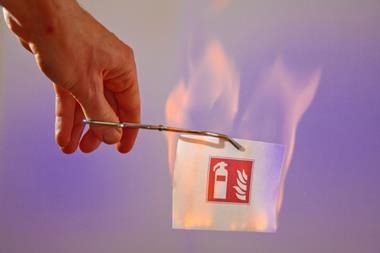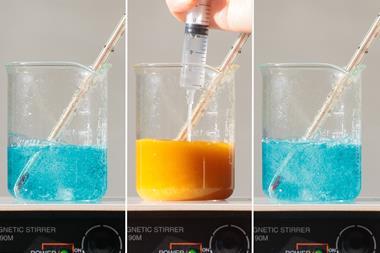Competition or displacement reactions are used to introduce patterns in reactivity. Demonstrations commonly include the thermite reaction, and a range of metals with copper(II) oxide. While the thermite reaction provides an unforgettable spectacle, the smoldering beauty of the reaction between zinc metal and copper(II) oxide provides a number of learning opportunities and links with further demonstrations associated with acid–base chemistry, properties of metals, metal extraction and purification.
Kit
- Eye protection
- Five 100 cm3 beakers
- A balance
- Copper(II) oxide powder, 2.0 g (harmful)
- Zinc powder, 1.8 g (highly flammable)
- Tin lid sitting on a tripod
- Safety screens
- Bunsen burner or blowtorch
- Borosilicate test tube and holder
- Zinc oxide, a few grams (harmful)
- Hydrochloric acid, approximately 2 M, 20 cm3 (irritant)
- Circuit tester (power pack, bulb, crocodile clips and leads)
- Strips of copper metal
- Copper(II) sulfate solution, approximately 0.1 M (irritant)
- Two graphite electrodes
Preparation
Weigh out the zinc powder and copper(II) oxide into two separate beakers and then mix thoroughly by passing from one to another. Pour the mixture out into a line, approximately 5 cm long, on the tin lid.
In front of the audience
Invite students to examine the dark grey mixture and suggest what evidence they expect to see when a chemical reaction occurs between the two powders.

Heat one end of the mixture with a roaring Bunsen flame until it begins to glow. You may need to chase the glow down the line, as the consistency of zinc powder can vary. The reaction will burn with a bright green flame, due to the copper. As soon as the reaction subsides, invite students to notice the yellow and white powder that is present, and also the red–brown powder indicating the presence of copper. As the reaction cools, the yellow powder will turn white indicating the presence of zinc oxide. Confirm by heating a separate sample of zinc oxide in a test tube, which will turn yellow then return to white as it cools.
Once cool, the sample (now a brittle lump) can be passed around for examination. Your students may know the zinc oxide could be removed using hydrochloric acid, with which the copper will not react. Place the lump in a beaker with the acid. The oxide layer will dissolve away along with any unreacted zinc (which may release a few bubbles of hydrogen gas) to give a colourless solution and leave the lump uniformly red–brown in colour. This will conduct electricity.
By comparing the conductivity of the lump with that of a strip of copper, students will see the lower conductivity of impure copper.
A suitable purification technique is electrolysis. Weigh the copper strip and connect it by crocodile clip to the negative terminal of the powerpack. The lump of impure copper can be connected to the positive terminal – there is little point weighing it as pieces will break off into solution. Electrolysing between 4 and 6 V in copper(II) sulfate solution for a few minutes will leave a visible deposit of copper on the copper strip – this can be patted dry and reweighed. Students may be rightly suspicious of the copper in solution, so it is worthwhile setting up an additional cell with graphite electrodes which will get visibly paler over time and indicate the consumption of the dissolved copper.
Teaching goal
This reaction fits nicely into any introductory sequence associated with metal extraction, redox or the activity/reactivity series. The various stages provide evidence of chemical changes through the strongly exothermic reaction, the release of light energy, the observed colour changes, the change in conductivity of the copper sample, and the production of gas in both the reaction with acid and the electrolysis.
The thermochromic change seen between the two forms of zinc oxide is worthy of discussion – the easy reversibility of the change would perhaps indicate a physical change, but the change in colour suggests a chemical one. The division between physical and chemical changes is to some extent a model, limited by our language and our way of looking at a reaction. In this case, changes in the crystal arrangement could be thought of as a physical change, however at temperatures above 800°C, small amounts of oxygen are lost from the lattice as well, disrupting the stoichiometry of the lattice. The oxygen can be reabsorbed from the atmosphere on cooling – a chemical change.
Note
Updates have been made to a number of these types of demonstrations following changes in UK explosives legislation – check with CLEAPSS or SSERC to ensure your current risk assessment and quantities are up-to-date.
Downloads
Technicians notes
Word, Size 84 kbTechnicians notes
PDF, Size 71.76 kbPowerPoint slides with animations
PowerPoint, Size 2.77 mb




















No comments yet